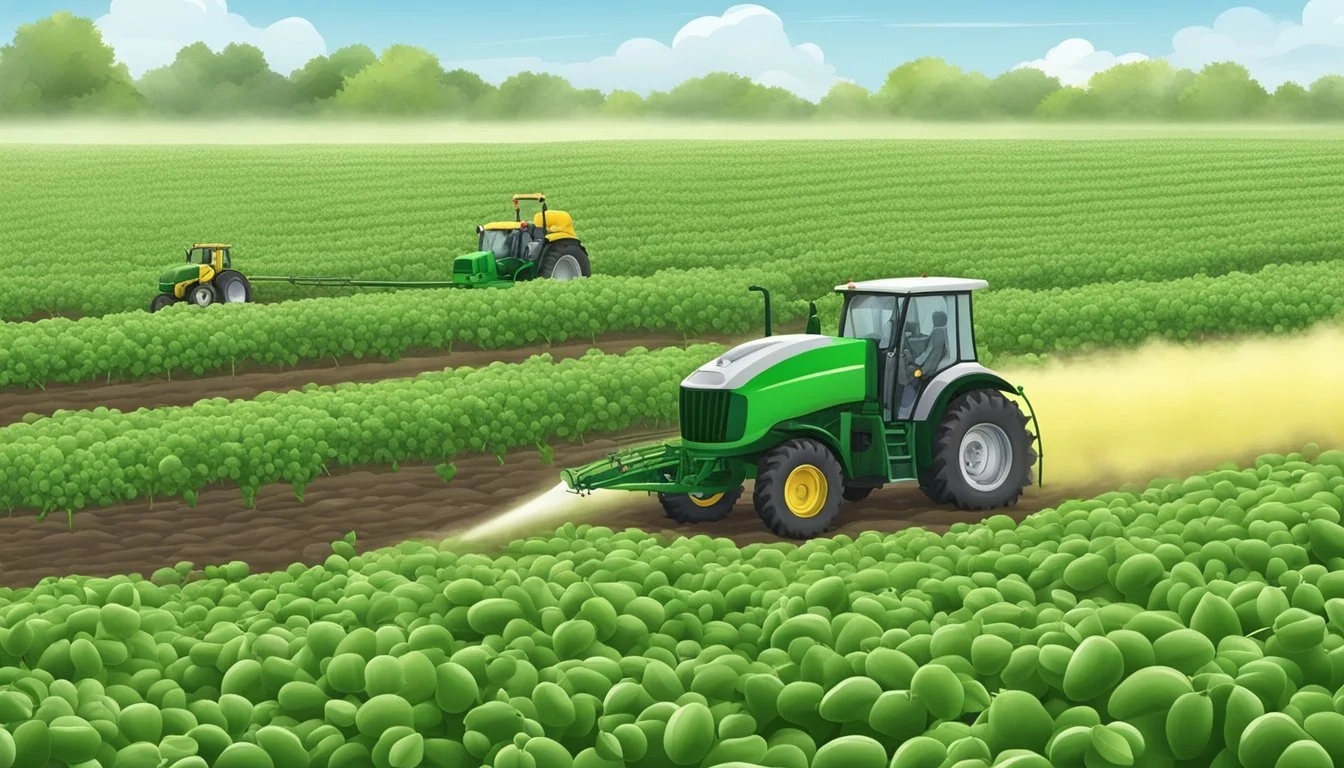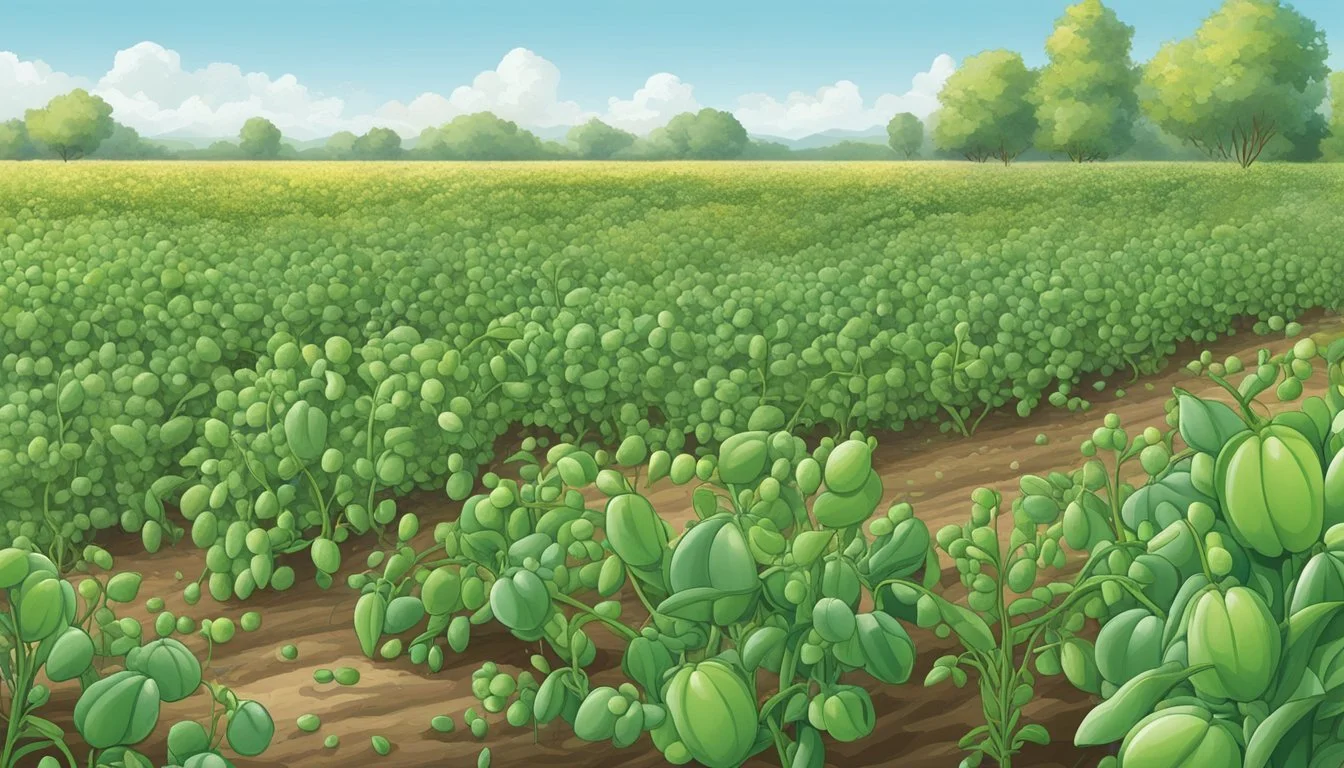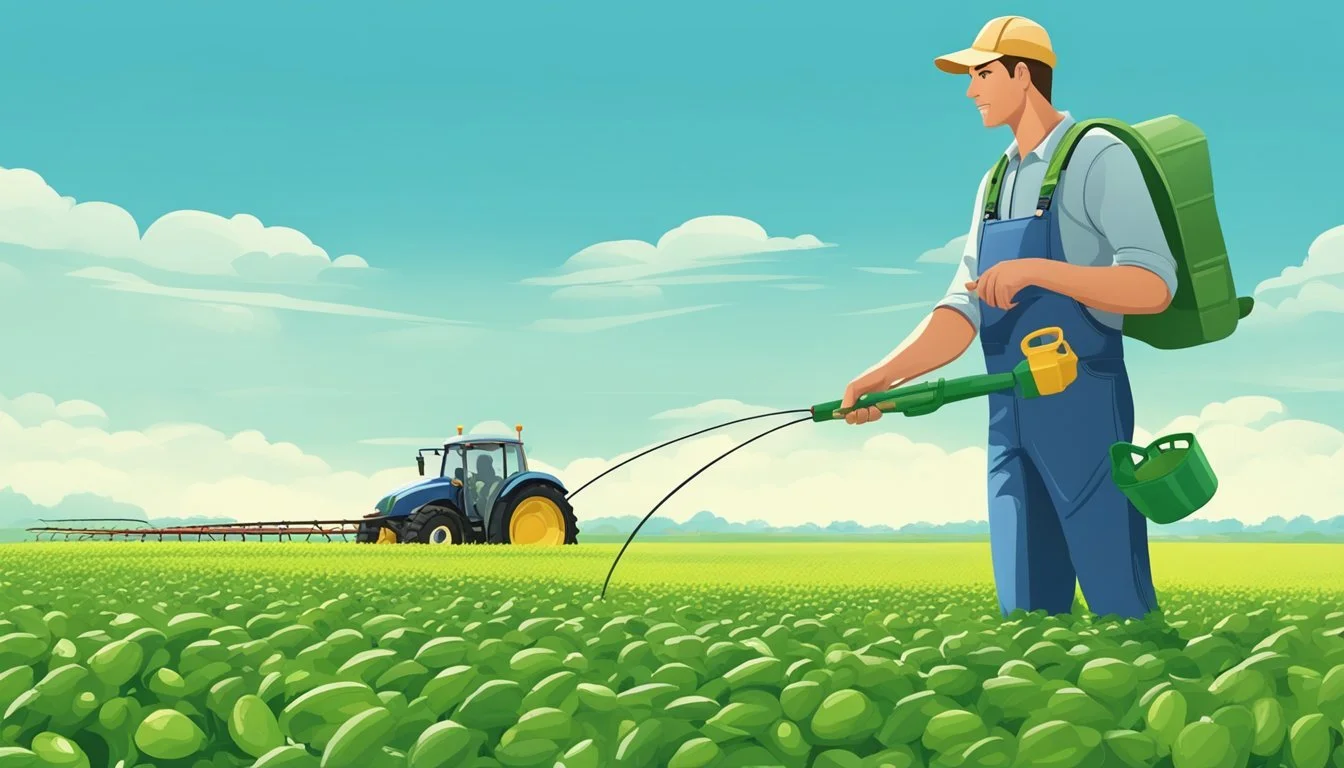Pest Control for Field Peas
Effective Strategies for Healthy Crops
Field pea crops are an important agricultural commodity, valued for their nutritional benefits and versatility. However, their yield and quality can be significantly compromised by a range of insect pests. These pests not only damage the plants directly by feeding on the foliage, stems, and pods, but they can also act as vectors for disease, leading to further crop loss. Effective pest control is thus paramount for the success of field pea cultivation.
Understanding the lifecycle and behavior of common pests such as aphids, weevils, and stink bugs is crucial for their management. Pest control methods vary and may include cultural practices, biological controls, and the careful application of insecticides. Farmers need to be vigilant and adopt an integrated pest management strategy to protect their crops from these detrimental insects.
Timely monitoring and accurate identification of pests allow for more targeted control measures, which are not only more effective but can also be less harmful to the environment. The overall goal of pest management in field pea crops is to minimize damage while ensuring the sustainability of the farming practices. With the correct approach, it is possible to maintain healthy, productive pea fields that can withstand the challenges posed by insect pests.
Understanding Pest Dynamics in Field Peas
Effective pest management in field pea cultivation is critical to ensuring healthy crop yields. An in-depth understanding of the pests involved, their life cycles, and behaviors is essential for timely and accurate interventions.
Identification of Common Pests
A variety of insects infest field peas including aphids, which can transmit viruses, and cutworms which damage seedlings. Beetles such as the bean leaf beetle and Mexican bean beetle are known to defoliate plants, while weevils, particularly pea weevils and cowpea weevils, can harm developing seeds. Pea leaf weevil larvae feed on root nodules, impairing nitrogen fixation. Armyworms and caterpillars pose a risk by consuming foliage, and leafminers create trails in leaves which can reduce photosynthetic ability.
Fungal diseases like ascochyta blight can significantly damage field peas, as can viral diseases spread by pests. Pea plant diseases such as powdery mildew are caused by various species of fungi. Biological factors like ladybugs can be effective in controlling aphid populations.
Pest Life Cycles and Behavior
Understanding the life cycles of pests is essential for effective pest management. Eggs laid by pests hatch into larvae or nymphs, which then develop into adults. For instance, the cowpea curculio lays eggs in the seed pods, and the hatching larvae feed on the seeds, causing significant damage.
Spider mites, which are microscopic mites, and thrips, including flower thrips, have quick reproduction cycles and can rapidly overrun a field pea crop. Nematodes, microscopic roundworms, can attack pea roots, impacting the overall health of the plants.
Beetles, weevils, and aphids display different feeding behaviors, from leaf and pod damage to sap extraction, which can facilitate the transmission of diseases and viruses to the plants. Beneficial insects, on the other hand, such as ladybugs, prey on harmful insects, reducing their numbers naturally.
Cultural and Biological Control Strategies
In agricultural practices, cultural and biological control strategies are foundational to reducing pest populations. These methods are especially pivotal for crops like field peas where maintaining balance in the ecosystem can significantly diminish pest-related issues.
Crop Rotation and Field Management
Crop rotation is an essential aspect of cultural control. It interrupts the life cycles of pests by varying the crops planted in a sequence over several seasons. For instance, alternating between field peas and crops such as corn, cotton, peanuts, and tobacco can help prevent the buildup of pea-specific pests in the soil. In Florida and Georgia, crop rotation has been utilized to manage pests organically in home gardens and larger farming operations alike.
Field management techniques like the proper timing of planting and harvesting, as well as the eradication of crop residues, are also effective in thwarting pest infestations. For example, growers in the South may plant southern peas after early spring vegetables to avoid peak insect populations.
Beneficial Insects and Natural Predators
Integrating beneficial insects and natural predators into the ecosystem is a cornerstone of biological control. Ladybugs, for example, are voracious predators of aphids and other pests that can damage field peas. The use of neem oil is another organic method to control various insects and diseases without harming these beneficial organisms.
It is crucial to understand the types of natural predators present and their impact on pest populations. This knowledge can then inform decisions about which organic products or methods to use in order to preserve these allies. Through careful management and support of these natural systems, growers can effectively mitigate pest issues in field peas and many other vegetables.
Chemical Control Measures
Chemical control measures are essential for protecting field peas from a variety of pests, diseases, and fungal infections. Employing the right insecticides and pesticides is crucial not only to curb the impact of pests such as caterpillars and thrips but also to manage diseases like fusarium wilt and root rot. This section focuses on the selection of appropriate chemicals and the best practices for their application.
Selecting Appropriate Insecticides
When choosing insecticides for field peas, it's vital to consider the specific pests and diseases present. For instance, fusarium wilt and root rot are fungal diseases that require the use of a targeted fungicide, while powdery mildew and mosaic virus present another category of challenges that demand specific types of treatments. Regarding insect pests, neem oil can be an effective organic option against caterpillars and thrips.
Here is a list of common chemical control substances used in field peas:
Insecticides: Target specific insect pests (e.g., caterpillars, thrips)
Synthetic options
Organic options, such as neem oil
Fungicides: Combat fungal diseases (e.g., powdery mildew, fusarium wilt)
Pesticides: Broader spectrum products that can handle multiple issues if needed
Application Timing and Techniques
Achieving the maximum efficiency of chemical control measures depends on correct timing and application techniques. It's necessary to apply fungicides before the onset of disease for preventative measures, especially for diseases like fusarium wilt and powdery mildew. For insect pests, the timing is crucially dictated by the pest's life cycle and the growth stage of the pea plants. For example, treatments for caterpillars and thrips must coincide with the most vulnerable stage of the pest to be effective.
Best Practices for Application:
Timing: Apply fungicides preemptively; With insecticides, target critical stages of pest development.
Techniques:
Use recommended doses and methods as described on product labels.
Ensure thorough coverage of the plant, including undersides of leaves where pests often reside.
Effective chemical management involves a combination of choosing the right product and applying it effectively at the correct time, ensuring the protection and health of field peas with minimal environmental impact.
Physical Pest Control Approaches
Effective pest management in field peas often includes physical control strategies. These methods are targeted to reduce pest populations and minimize crop damage through direct interventions.
Mechanical Barriers and Traps
Mechanical barriers, such as row covers or nets, prevent pests from reaching field pea plants. These are particularly useful for deterring larger insects or birds without the use of chemicals. Traps, on the other hand, capture or kill pests. For example, pitfall traps and sticky traps are employed to monitor and control insect populations that could harm field pea crops.
Sanitation and Crop Debris Management
Proper sanitation is critical in maintaining garden hygiene. Clearing away old plants and crop debris eliminates potential hiding places and breeding grounds for pests. In home gardens and commercial fields alike, the consistent removal of decaying plant material significantly lowers the risk of pest infestations, disrupting the life cycle of many garden pests.
Monitoring and Thresholds for Pest Control
Effective pest control in field peas requires diligence in monitoring and understanding when to take action. Two critical components are regular scouting and record-keeping, and determining economic threshold levels to prevent significant damage while minimizing unnecessary interventions.
Regular Scouting and Record-Keeping
Regular inspections of field pea crops are paramount to identifying pest presence before an infestation spirals out of control. It is recommended that farmers inspect their crops at least once a week, focusing on the undersides of leaves, pods, and seeds, where pests like aphids and mites tend to congregate. During each examination, specific findings should be meticulously recorded, detailing the number of pests per plant and the overall health of the crop. This data assists in tracking pest population dynamics over time and in detecting the early stages of infestation which is crucial for timely and effective management.
Determining Economic Threshold Levels
Economic threshold levels define the pest density at which the cost of damage exceeds the cost of control measures. For example, treatment for pests such as aphids should commence if one finds that the crop is susceptible to pest attack, particularly from pod-set through to maturity. To apply this principle, one must identify and count pests such as aphids or mites. If the presence of pests like Helicoverpa, commonly known for causing damage during pod-set, hits a predetermined threshold, it signals the need for immediate control measures, such as the application of insecticidal soaps or other management tactics. Establishing these thresholds, based on both the presence and the concentration of pests, supports informed decision-making to effectively protect the yield and quality of the field pea crop while ensuring economic sustainability.
Preventive Measures and Resistant Varieties
Effective management of pests in field peas often starts with preventative strategies and the selection of resistant varieties. These foundation steps can significantly reduce the impact of common diseases and pests like fusarium wilt and mosaic virus.
Seed Choice and Genetic Resistance
Seed selection is crucial in preventing pest outbreaks. Choosing seeds that are genetically resistant to diseases like fusarium wilt, downy mildew, and blight greatly enhances crop resilience. For example, resistance to the mosaic virus can be a key trait in seed varieties, providing inherent protection for the plants. Research on disease-resistant pea varieties shows that selecting the right seeds is a cornerstone of effective pest management.
Genetic resistance not only minimizes the need for chemical interventions but also contributes to sustainable agriculture practices by enhancing the plants' ability to withstand attacks naturally.
Pre-emptive Action Against Known Threats
Crop rotation is a foundational preemptive action. Rotating peas with non-host crops breaks the life cycle of pests and diseases, such as bacterial blight, that can otherwise proliferate in continuous cropping systems. Integrating a variety of crops can suppress the buildup of soil-borne pathogens and pest populations, leading to healthier plants and yield.
Preemptive measures include proper field hygiene and sanitation to eliminate potential sources of infection. Removal of plant debris and the control of weeds that may harbor pests are essential steps in preemptive pest management. Addressing these threats before they establish can greatly reduce the need for more aggressive control methods later on.
Pest Control in Specific Environments
Pest management in field peas requires tailored strategies according to the environment. Factors such as space availability, pest type, and control methods differ greatly between home gardens and agricultural settings.
Challenges in Home Gardens
Home gardens provide a unique set of challenges for pest control due to their smaller scale and close proximity to human living spaces. Garden hygiene plays a crucial role in preventing infestations. Regular removal of plant debris and weeds can limit pest habitats. It's essential for gardeners to maintain spacing between plants to reduce the spread of pests and diseases. Organic methods are often preferred in home gardens, including the use of beneficial insects or homemade plant sprays, to limit chemical exposure in the family’s green space.
Field Pea Pest Management in Agriculture
In an agricultural context, pest management strategies are designed to cover larger areas and are often guided by economic thresholds to determine the necessity and timing of interventions. Monitoring methods, as indicated by the Grains Research and Development Corporation, dictate when to take action. Measures taken in commercial field pea farming often include a mix of chemical and biological controls, aligned with USDA-recommended practices to ensure crop safety and quality. Precision in application and adherence to pesticide guidelines are pivotal in these settings for effective pest control.
Integrated Pest Management (IPM) for Field Peas
Integrated Pest Management (IPM) is a comprehensive approach to controlling pests in vegetable crops like field peas. It emphasizes the use of a variety of methods to reduce reliance on chemical pesticides while aiming to protect the crop and environment effectively.
In home gardens and commercial field pea production, IPM strategies can be broken down as follows:
Cultural Control: This involves practices such as crop rotation to disrupt pest life cycles. A diverse rotation scheme prevents the buildup of pea-specific pests in the soil.
Physical Control: Methods include using barriers or traps to prevent pests from reaching the plants.
Biological Control: This exploits natural enemies of pests, like predators or parasitoids, to keep pest numbers in check.
Chemical Control: Pesticides are used as a last resort and in a targeted fashion to minimize impact on non-pest species.
A critical component of IPM is accurate and regular pest monitoring. This helps to identify the types of pests present and assess their levels. Decisions regarding control measures are made based on established thresholds; this means that action is only taken when pest populations reach a level that threatens significant damage to the crop.
Here's an IPM checklist for field peas to showcase how diverse strategies are integrated:
Step in IPM Process Description Identify Pests Regular scouting to catch early signs of infestation. Monitor Population Levels Use traps and visual inspections to determine if intervention is necessary. Apply Cultural Controls Utilize crop rotation and sanitation to prevent pest establishment. Employ Biological Controls Enhance habitats for natural predators and introduce beneficial organisms if appropriate. Use Chemical Controls Judiciously Selective pesticide application based on careful monitoring and thresholds.
Through pest management practices outlined in IPM, farmers and gardeners can protect their field peas while promoting a sustainable approach to agriculture.
Frequently Asked Questions
Pest management in field peas is crucial for ensuring a successful harvest. This section answers common questions regarding low-cost pest control, effective management methods, pest identification, pesticide application best practices, herbicide recommendations, and control of pea aphids.
How can one effectively manage pests in field peas without incurring high costs?
Effective pest management in field peas can be achieved through integrated pest management (IPM) approaches, which combine cultural, biological, and chemical methods. Regular monitoring of pest populations and employing economic thresholds for pea aphids can reduce unnecessary pesticide applications, lowering costs.
What are the optimal pest control methods for field peas?
Optimal pest control for field peas includes crop rotation, timely planting, and the use of resistant varieties. Chemical controls should be used as a last resort and based on accurate pest identification to ensure they target the right insects.
Which insects commonly infest field peas, and how are they identified?
Common insects that infest field peas include stink bugs, which can be identified by their bright green, shield shape, and bad-smelling defense mechanism, and pea aphids, which are identified by their small, green, or pink soft body.
What are the best practices for applying pesticides to field peas?
The best practices for applying pesticides to field peas include following label directions carefully, applying during calm weather to avoid drift, and spraying only when pests reach an economic threshold to minimize the impact on beneficial organisms and reduce the development of resistance.
Which post-emergence herbicides are recommended for use in pea cultivation?
Post-emergence herbicides that selectively target problem weeds without harming field pea crops include those with active ingredients such as bentazon and imazethapyr. However, it's important to consult a local agricultural extension for specific recommendations that comply with regional regulations and address local weed pressures.
How can pea aphids be effectively controlled in field pea crops?
Pea aphids can be effectively controlled by scouting early and applying foliar insecticides when the population exceeds the economic threshold. Natural predators like lady beetles should also be encouraged as they can help keep aphid populations in check.










